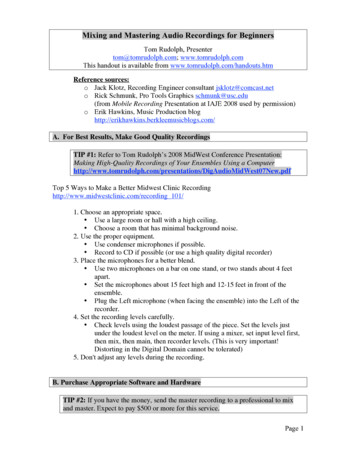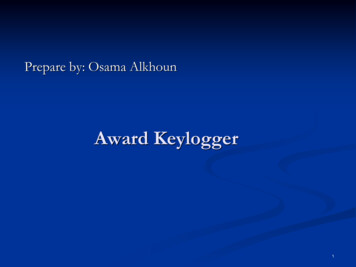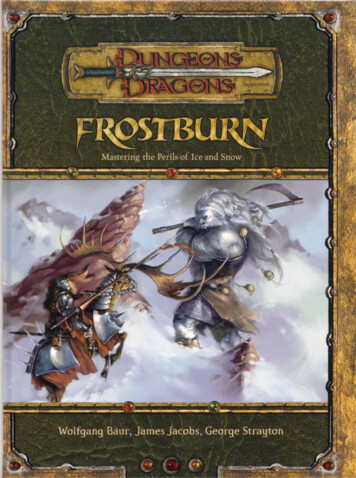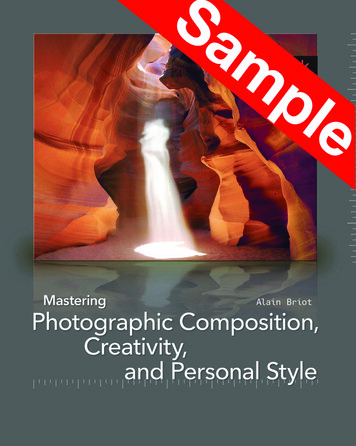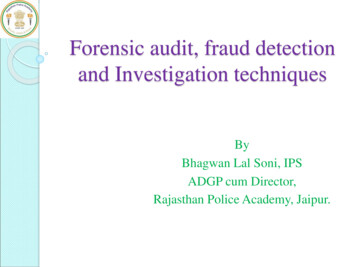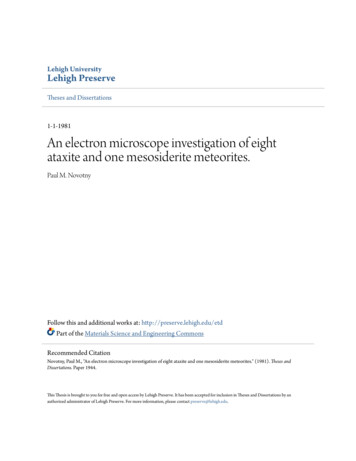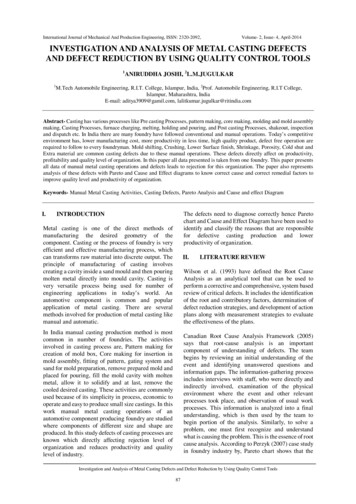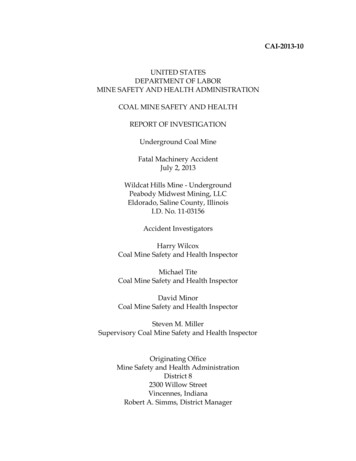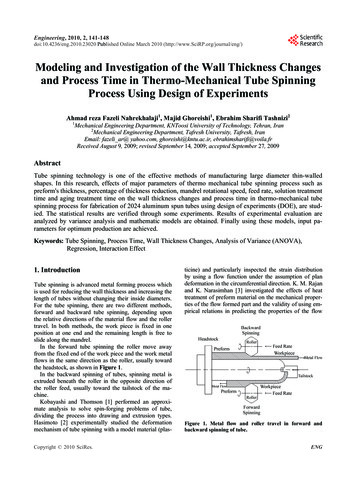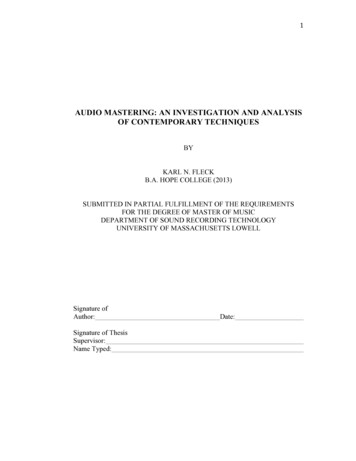
Transcription
1AUDIO MASTERING: AN INVESTIGATION AND ANALYSISOF CONTEMPORARY TECHNIQUESBYKARL N. FLECKB.A. HOPE COLLEGE (2013)SUBMITTED IN PARTIAL FULFILLMENT OF THE REQUIREMENTSFOR THE DEGREE OF MASTER OF MUSICDEPARTMENT OF SOUND RECORDING TECHNOLOGYUNIVERSITY OF MASSACHUSETTS LOWELLSignature ofAuthor:Signature of ThesisSupervisor:Name Typed:Date:
2AbstractMastering is an aspect of music production that is encompassed by air of mystery.There is very little specific information written about mastering and it isoftentimes overlooked in common collegiate Audio Engineering curricula. Thepurpose of this study is to investigate audio mastering and examine its finerdetails. In this study a single song was recorded; mixed by four different mixingengineers; and finally collected, analyzed, and mastered. Furthermore, interviewswere conducted with five prominent mastering engineers regarding the manyspecific facets of mastering. These interviews were then transcribed and analyzedfor common trends and practices. The goal is to illuminate various techniques formastering while utilizing these examples in the context of a case study.Throughout this study, several themes emerged including the need for accuratemonitoring, specified equipment, experience, and a touch of luck. Theinformation gathered in this study will benefit those interested in understandingmastering. This could range from students wishing to pursue a career inmastering, to artists looking to comprehend how the mastering process affectstheir work.
3AcknowledgementsI would like to offer my most sincere thanks and gratitude to AlanWilliams and the rest of the members of Birdsong at Morning, Darleen Wilsonand Greg Porter. Your cooperation, musical wisdom, and guidance has truly beentreasured.I would also wish to thank my advisor Alex Case for his support, direction, andthe 3:01 meetings that we have had to brainstorm every aspect of this project.To the crew at M-Works: Jonathan Wyner, Alex Psaroudakis, and Nick Dragoni:the time spent with you all has been one of my most valued educationalexperiences. Your open communication about mastering has profoundly shapedmy thoughts and practices of this art form. It has been through my time with youthat I have learned to be truthfully critical in all aspects of mastering.In a similar fashion, my deepest thanks goes out to the mastering engineers thatparticipated in the interviews, Jay Frigoletto, Matt Azevedo, Adam Ayan, PaulAngelli, and Jonathan Wyner. Open and honest communication about masteringis difficult to come by and I genuinely appreciate every thought and concept thatyou all have discussed in our interviews.
4This project would be nothing without the participation of my trusted mixengineers, Alan Williams, Nick Dragoni, Brandon Vaccaro, and BradfordSwanson. Thank you for the time, consideration, and creativity that you haveinvested in my project.Lastly, to my wife Hannah, thank you for your support, editing skills, andwillingness to listen to all of this mastering ‘nonsense’ that I constantly talk about.
5Table of ContentsI. Introduction – OverallI. A Guide to Common Practices in Mastering Politics and Communication The Mastering Process: Typical Signal Path Assessing the Mix The Expertise of a Mastering Engineer The Monitor Path: Flat and Pristine First Steps: Signal Routing Timbral Balance: Application of Equalization Analog Minimum Phase EQ vs. Digital Linear Phase Flavors of EQ in Mastering Optimizing Loudness with EQ Common EQ Units in Mastering Compression: The Gains of Gain Reduction Compression Settings and Options for Mastering Other Uses of Compression Limiting: The Final Creative Step Less is More and More is More The Final Step of the Mastering Process Final ThoughtsII. Literature Cited91113141720202325262729303031343537383942II. Section 1: Interviews with Mastering Engineers43I. Introduction and II. Methodology Part 1. A Series of Questions Mastering Subjective Language434347II. Results: Interviews with Mastering Engineers Jay Frigoletto Matt Azevedo Adam Ayan Paul Angelli Jonathan Wyner494984104139159III. Discussion: A Summary of the Responses Part 1. Specific Questions About Mastering Part 2. Mastering Subjective Language185185190
6IV. Conclusions Part 1. Specific Questions About Mastering Part 2. Mastering Subjective Language194194198V. Recommendations201VI. Literature Cited202III. Section 2: Production of “All the Sadness”203I. Introduction and II. Methodology The Recording Process The Mixing Stage Mix Engineer Instructions Receiving the Mixes Finding a Mastering Room A Note on DAW’s: Ozone 7 and Pyramix 7 Preparing the Mixes The Mastering Session203204217218220222226228228III. Results First Impressions: Mix 1: Alan Williams Mix 2: Nick Dragoni Mix 3: Brandon Vaccaro Mix 4: Bradford Swanson Common Steps Taken The Mastering Process for Each Mix Master 1: Alan Williams Master 2: Nick Dragoni Master 3: Brandon Vaccaro Master 4: Bradford Swanson Master 5: The EP Match Sequencing in V. Discussion The Mastering Process: Thoughts on a Tech. Issue254254V. Conclusion General Trends and Conclusions257257
7VI. Recommendations259VII. Literature Cited261IV. Conclusion – Overall262V. Appendix265VI. Biographical Sketch266
8List of Figures1. Communication Routes2. Fletcher-Munson Curves3. Playback System Bell-Curve4. Basic Hybrid Signal Path5. Interviews Averaged Frequency Ranges6. Session 1 Input List7. Session 1 Floorplan and Mic Placement8. Session 2 Input List9. Session 2 Floorplan and Mic Placement10. Session 3 Input List11. Session 3 Floorplan and Mic Placement12. Session 4 Input List13. Session 4 Input List14. M-Works Mastering Main Room (December 2015)15. Room 114 Proposed Hybrid Signal Path16. Final Signal Path17. Ozone Level Matching Option18. Final Signal Path (2)19. Common Processing Chain20. Alan Williams Limiter Settings21. Alan Williams EQ Settings22. Alan Williams Dynamics Settings23. Nick Dragoni Stereo EQ Settings24. Nick Dragoni M/S EQ Settings25. Nick Dragoni Dynamics Settings26. Nick Dragoni Imager Settings27. Brandon Vaccaro EQ Settings28. Brandon Vaccaro Dynamic EQ Settings29. Brandon Vaccaro Dynamics Settings30. Brandon Vaccaro Imager Settings31. Bradford Swanson EQ Settings32. Bradford Swanson Dynamics Settings33. Pyramix Edit Window34. Pyramix Fade Editor Window35. Pyramix CD Image Generatorp. 13p. 19p. 21p. 23p. 200p. 206p. 207p. 209p. 210p. 212p. 213p. 215p. 216p. 223p. 224p. 225p. 227p. 229p. 233p. 236p. 238p. 239p. 240p. 240p. 241p. 242p. 243p. 243p. 244p. 244p. 246p. 247p. 251p. 252p. 253
9I. Introduction- OverallMastering is the least understood step in the production of professionalcommercial audio. This final step in the professional recording process is highlyspecified, competitive, and thus notoriously secretive. In the current state of themusic industry with increasing numbers of home studios, professional audiomastering has become a topic of significance. This is due to the fact of theincreasing numbers of artists who want their productions to be mastered, but oftencannot afford to send their project to high-end mastering studios. This creates ademand for low-cost mastering that has the potential to be detrimental to thequality of music production, leading to the employment of inexperienced and illequipped mastering engineers. In order to combat the general lack ofcomprehension of mastering, information on its finer processes and details mustbe shared; artists, audio professionals, and the general public must be informed inorder to make the best decisions for musical production and the audio industry.Currently, there are several resources that contain information about audiomastering. There are some informal articles and videos that can be found online,such as those by Mike Collins and Johnathan Wyner, and there are a fewtextbooks published about mastering. Two of the most authoritative textbooks areMastering Audio: the Art and the Science by Bob Katz (2007) and AudioMastering: Essential Practices by Jonathan Wyner (2013). These books providean introduction to mastering and are vital resources for learning about the
10common elements of mastering including effects processing, file formats, andgeneral mastering aesthetics.These two textbooks are tremendous resources for attaining anintroduction to the concepts of the mastering process. Furthermore, Wyner’s bookfeatures two “case studies” where he walks the reader through the mastering oftwo sample recordings. This takes the concepts presented in the book and makesthem practical, providing the reader with the implementation of specific examplesof the mastering process. Even though Wyner includes these “case study”examples in his book, the details and processes of other techniques could beexplained further. Because mastering is a diverse discipline and the process isspecific to the genre of music, it is not enough to talk about mastering in generalterms. Additionally, it is much more meaningful to discuss mastering when theconcepts are put into context. Despite these great resources, there is still a lack ofvariety and depth of mastering literature and resources.This study further investigates the details of mastering, providingexamples for a specific discussion about the mastering process. It providesinformation relevant to audio engineers, producers, and artists who might notfully understand all that mastering entails. This study is separated into twosections. The first is section is comprised of a series of interviews conducted withveteran mastering engineers. This section allows mastering engineers to talk abouttheir craft, oftentimes citing specific examples relating to their past projects andexperiences. The goal of these interviews is to provide relevant and valuableinsight into the current state of mastering.
11The second section of this study focuses on the recording of one song;four different mixes by four different mix engineers; and the mastering of thosefour mixes. This section offers insight into the entire audio production chain andfocuses on the final mastering of the four mixes of a single song. Furthermore,one of the mixes was a part of an EP match exercise which is another aspect ofmastering that requires a differing approach than mastering for a “single.”This study combining these two sections provides relevant informationabout many aspects of audio mastering. It examines the responses in theinterviews of mastering engineers and analyzes the mastering process in thecontext of four different mixes of the same song. The purpose of this study is toinvestigate examples that provide a context for specific discussions aboutcontemporary mastering techniques. The following section, “A Guide to CommonPractices in Mastering,” lays the groundwork for this studies’ investigation of theaudio mastering process.A Guide to Common Practices in MasteringTo reiterate, mastering is the most misunderstood step in the recordingprocess. There exist rumors of mythical audio alchemy and Wizard-of-Oz-style“man behind the curtain” trickery. This lack of understanding may be true forsome audio professionals, but even more so, it is especially true for audioengineering students who are primarily taught about the recording and mixingprocesses.
12So then, what actually happens during the mastering process? What aresome of the mastering methods used to alter a piece of audio? The following is aguidebook that elucidates some of the common practices of mastering,specifically in manipulating a two-track, stereo piece of music. Included in thisguide are tips, techniques, and tools used to transform raw mixes into polishedmasters.Politics and CommunicationBefore diving into the technical and artistic sides of audio mastering, theremust first be a discussion on the politics of dealing with clients. Mastering doesnot exist without clients—period. Therefore, one of the most crucial aspects ofmastering is keeping the client happy; always remember: “the client is king.”Though it may seem like common sense for some, this is not an easy concept toaccept for others. However, once the “client is king” mentality is adopted, boththe client and mastering engineer will be pleased throughout the entire masteringprocess.Therefore it is crucial to not allow ego to get in the way of the client’sdesires. This is not to say one cannot offer expert, educated opinions. Instead, tryto educate the client about the situation as politely and respectfully as possible. Inthe end, if it comes down to a matter of artistic taste, trust the client. However, ifit is a matter of technical limitations or misunderstandings, try to inform theclient.
13Another area of client-mastering engineer relations is the need forrevisions. Revisions are a necessary part of mastering. Once the program materialhas been received and the masteringengineer does a first pass, areference should be sent to the client.This gives everybody involved anidea of the direction in which theproject is going. The masteringengineer can think about what needsFigure 1. Communication Routesto happen while the artist can get an ideaof how the mastering engineer interprets and assesses the mix. Revisions arecommon, but the goal for the mastering engineer is to try to understand the intentof the artist and get the master exactly how the client wants the material to sound.Figure 1 demonstrates the ideal route of communication in a music productionchain where there is continual contact between everyone involved in theproduction.Lastly, shootouts are another aspect of the client-mastering engineerrelationship. Shootouts may not happen often but they do happen and at somepoint every mastering engineer will take part in one. There are two types ofshootouts and for the sake of the project, they will be referred to as: “covert” and“overt.” During a covert shootout, oftentimes clients will send a m
Mastering Audio: the Art and the Science by Bob Katz (2007) and Audio Mastering: Essential Practices by Jonathan Wyner (2013). These books provide an introduction to mastering and are vital resources for learning about the . 10 common elements of mastering including effects processing, file formats, and general mastering aesthetics. These two textbooks are tremendous resources for
